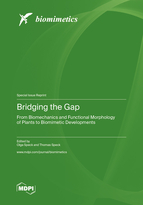Bridging the Gap: From Biomechanics and Functional Morphology of Plants to Biomimetic Developments
A special issue of Biomimetics (ISSN 2313-7673).
Deadline for manuscript submissions: closed (30 September 2021) | Viewed by 32260
Special Issue Editors
Interests: bioinspired materials systems: self-repairing materials systems, adaptive materials systems, and composite materials; functional morphology and biomechanics of plants; biomimetics and sustainable technology development; education and training in the field of biomimetics
Interests: functional morphology and biomechanics of plants; plant–animal interactions; bioinspired materials systems, structures, and surfaces; phylogeny of plants and functional structures; paleobotany; scientific education and training in botanic gardens
Special Issues, Collections and Topics in MDPI journals
Special Issue Information
Dear Colleagues,
This Special Issue, entitled “Bridging the Gap: From Biomechanics and Functional Morphology of Plants to Biomimetic Developments”, will cover the entire development chain from basic research in the field of biomechanics, simulation of the functional morphology of plants, and the development of physical models for a better understanding of functional principles to biomimetic products on the laboratory scale or prototype level. The size scale can be any hierarchical level, from (macro-)molecules to entire plants.
In general, plants can be regarded as fibre-reinforced materials systems defined by a number of material properties. As materials systems consisting of various components with different material properties, they are not only anatomically inhomogeneous and mechanically anisotropic, but also possess a spatial and temporal heterogeneity due to growth and their capacity to respond or adapt to changing environmental conditions.
We kindly invite you to contribute to this Special Issue with an experimental paper, a modelling/simulation paper, or a review article on any topic related to this subject.
Dr. Olga Speck
Prof. Dr. Thomas Speck
Guest Editors
Manuscript Submission Information
Manuscripts should be submitted online at www.mdpi.com by registering and logging in to this website. Once you are registered, click here to go to the submission form. Manuscripts can be submitted until the deadline. All submissions that pass pre-check are peer-reviewed. Accepted papers will be published continuously in the journal (as soon as accepted) and will be listed together on the special issue website. Research articles, review articles as well as short communications are invited. For planned papers, a title and short abstract (about 100 words) can be sent to the Editorial Office for announcement on this website.
Submitted manuscripts should not have been published previously, nor be under consideration for publication elsewhere (except conference proceedings papers). All manuscripts are thoroughly refereed through a single-blind peer-review process. A guide for authors and other relevant information for submission of manuscripts is available on the Instructions for Authors page. Biomimetics is an international peer-reviewed open access monthly journal published by MDPI.
Please visit the Instructions for Authors page before submitting a manuscript. The Article Processing Charge (APC) for publication in this open access journal is 2200 CHF (Swiss Francs). Submitted papers should be well formatted and use good English. Authors may use MDPI's English editing service prior to publication or during author revisions.
Keywords
- herbaceous and woody plants, including trees
- plant-inspired materials systems, structures, and surfaces
- plant movement
- plant–animal interaction
- fibre-reinforced bioinspired materials systems
- self-X-functions of natural and artificial materials systems
- biomimetic developments with life-like functions








